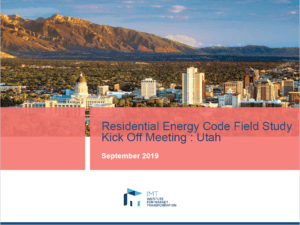According to the most recent EIA Residential Energy Consumption Survey, about one in five households reported reducing or forgoing basic necessities like food and medicine to pay an energy bill. While Utah currently ranks nationally with one of the lower average electricity bills ($82/month), improving compliance with the state’s residential building energy code will open up an array of benefits for homeowners, occupants, local governments, and building officials, including:
- Reduced energy costs that yield monthly savings for owners and occupants and boost the local economy.
- More comfortable and durable homes that better shield people from outdoor temperature extremes.
- Greater market certainty for the design and construction industry through consistent implementation across jurisdictions.
- A level playing field for all builders.
Improving Energy Code Compliance in Utah
IMT was awarded a U.S. Department of Energy (DOE) grant in June 2019 to launch a study aimed at understanding Utah’s statewide residential energy code compliance and to design and conduct a training, outreach, and education program to help close any gaps in code compliance. The project will follow on the work of eight initial studies completed from 2014-2019 in different states across the U.S. In these initial studies. IMT led the project work in Alabama, helping to analyze the current code compliance and create trainings to improve compliance and assist in the education around the adoption of a new residential energy code. The expansion of data collection to Utah will result in a greater understanding of residential construction issues in dry climate zones. The project in Utah will be split into two phases:
Phase 1: Baseline Study (anticipated September 2019 – March 2020)
The project team will conduct a baseline analysis of residential construction in the state that will inform a study of potential energy savings that would result from better code compliance. The baseline analysis will rely on site visits based on a sampling plan, a random proportional sample of construction that is developed from reported building permit data to reflect construction in the state.
Phase 2: Training and Outreach (anticipated March 2020 – April 2022)
The project team will provide targeted training and outreach based on the results of the baseline study to Utah’s building community, including designers, builders, code officials, and trade workers to try to eliminate the identified gaps in compliance with energy code.
How You Can Participate
PHASE 1: The project has begun the first phase which will include gathering data to understand compliance rates across the state. To achieve a statistically valid sample, a sampling plan has been developed by PNNL and accepted by the stakeholder group.
Building Departments: If your jurisdiction is on the sampling plan, our field data collection team from Nexant will be reaching out to you to request permit lists of active single-family construction projects. Any assistance you can give them in getting the information they need to complete the baseline assessment will be critical to the success of this work.
Builders: Once the permit lists have been obtained, our field data collection team will be reaching out to you to ask if they can have access to specific construction sites for field data collection. Any assistance you can give them in allowing them on site would go a long way in helping us quickly complete an accurate baseline assessment for the state.
Interested Parties: Interested in the results of the baseline? Have ideas or needs for training? Please reach out and we’ll keep you informed as the next steps occur. If you have questions about the project, feel free to contact Jake Duncan.
Project Updates
 |
IMT met with stakeholders to explain the study goals and methods, and to gather input for the sampling plan to collect study data in Salt Lake City on Tuesday, September 17, 2019. We thank to the Governor’s Office for Energy Development for hosting the event and all who came out to participate. View the kick-off meeting slides. |
Project Partners
IMT | Utah Clean Energy | SWEEP | Nexant | WC3 | Dominion Energy | Rocky Mountain Power
This material is based upon work supported by the Department of Energy, Office of Energy Efficiency and Renewable Energy (EERE), under Award Number DE-EE0008701. This report was prepared as an account of work sponsored by an agency of the United States Government. Neither the United States Government nor any agency thereof, nor any of their employees, makes any warranty, express or implied, or assumes any legal liability or responsibility for the accuracy, completeness, or usefulness of any information, apparatus, product, or process disclosed, or represents that its use would not infringe privately owned rights. Reference herein to any specific commercial product, process, or service by trade name, trademark, manufacturer, or otherwise does not necessarily constitute or imply its endorsement, recommendation, or favoring by the United States Government or any agency thereof. The views and opinions of authors expressed herein do not necessarily state or reflect those of the United States Government or any agency thereof.